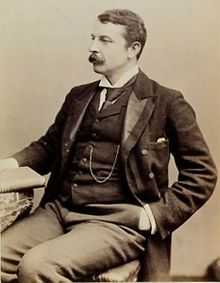Frank Evers Beddard
| Frank Evers Beddard | |
|---|---|
 | |
| Born |
19 June 1858 Dudley |
| Died |
14 July 1925 (aged 67) West Hampstead |
| Nationality | English |
| Fields | Annelid Zoology |
| Institutions | Zoological Society of London |
| Alma mater | New College, Oxford |
| Known for |
Annelids Animal coloration |
| Author abbreviation (zoology) | F.E.B. |
Frank Evers Beddard FRS (Dudley, 19 June 1858 – 14 July 1925, West Hampstead) was an English zoologist. He became a leading authority on annelids, including earthworms. He won the Linnean Medal in 1916 for his book on oligochaetes.
Life
Beddard was educated at Harrow. He studied at New College, Oxford.
Career
Beddard was naturalist to the Challenger Expedition Commission from 1882 to 1884. In 1884 he was appointed Prosector, responsible for preparing dissections of animals that had died, at the Zoological Society of London, following the death of William Alexander Forbes.[1]
Beddard became Lecturer in Biology at Guy's Hospital, Examiner in Zoology and Comparative Anatomy at the University of London, and Lecturer in Morphology at Oxford University.
Apart from his publications on wide-ranging topics in zoology, such as Isopoda,[2] Mammalia,[3] ornithology,[4] zoogeography[5] and animal coloration,[6] Beddard became particularly noted as an authority on the annelids,[7] publishing two books on the group and contributing articles on earthworms, leeches and also on another phylum of worms, the Nematoda for the 1911 Encyclopædia Britannica, where he used the initials "F.E.B.". Coles cites W.H. Hudson's 1919 The book of a naturalist, page 347:
- "One evening I was with Mr Frank E. Beddard at his club and taking advantage of the occasion, asked him some question about earthworms, he being the greatest authority in the universe on the subject."[7]
Beddard contributed biographies of zoologists William Henry Flower and John Anderson for the Dictionary of National Biography.
Beddard was the author of volume 10 (Mammalia) of the Cambridge Natural History.[3]
Legacy
Beddard's Olingo (Pocock, 1921) is named after him.[8]
Works
Books
- Report on the Isopoda collected by H. M. S. Challenger during the years 1873-76 HMSO, 1884.
- Animal Coloration: an account of the principal facts and theories relating to the colours and markings of animals Swan Sonnenschein, 1892.
- A Text-book of Zoogeography. Cambridge University Press, 1895.
- A Monograph of the Order of Oligochaeta. Oxford at the Clarendon Press, 1895.
- A Book of Whales. John Murray, 1895.
- The Cambridge natural history. Vol 10 Mammalia. Macmillan, 1895.
- Elementary Zoology. Longmans, Green, 1898.
- The Structure and Classification of Birds Longmans, Green, 1898.
- Mammalia, Macmillan, 1902.
- Natural History in Zoological Gardens: Being Some Account of Vertebrated Animals, Archibald Constable, 1905.
- Earthworms and Their Allies. Cambridge University Press, 1912.
Chapters
| English Wikisource has original text related to this article: |
| English Wikisource has original text related to this article: |
- Hudson, W.H. and Beddard, Frank E. British Birds. Chapter on structure and classification. First edition 1898. Longmans, Green, 1921.
References
- ↑ Beolens, Bo; Watkins, Michael; Grayson, Michael (2009). The Eponym Dictionary of Mammals. JHU Press. p. 33.
- ↑ Beddard, Frank Evers. Report on the Isopoda collected by H. M. S. Challenger during the years 1873-76 (Volume pt 11, 12), HMSO, 1884
- ↑ 3.0 3.1 Beddard, Frank Evers. (Edit: Harmer, Sir Sidney Frederic; Shipley, Arthur Everett, Gadow, Hans) The Cambridge Natural History, Volume 10, Mammalia. Macmillan Company 1902
- ↑ Beddard, Frank Evers. The structure and classification of birds. Longmans, Green, 1898
- ↑ Beddard, Frank Evers. A text-book of zoogeography. Cambridge University Press 1895
- ↑ Beddard, Frank Evers. Animal coloration; an account of the principal facts and theories relating to the colours and markings of animals. London, S. Sonnenschein & co.; New York, Macmillan, 1892
- ↑ 7.0 7.1 Coles, John W. Bibliography of the contributions to the study of the Annelida by Frank Evers Beddard with details of the material reported. Archives of Natural History. Volume 10, Page 273-315, DOI 10.3366/anh.1981.10.2.273, ISSN 0260-9541, 1981.
- ↑ Beolens, Bo; Watkins, Michael; Grayson, Michael (2009). The Eponym Dictionary of Mammals. JHU Press. p. 33.
External links
| Wikimedia Commons has media related to Frank Evers Beddard. |
- Biography
- Biodiversity Heritage Library: 20 Titles by Beddard
- Archives hub: Beddard's Correspondence
|